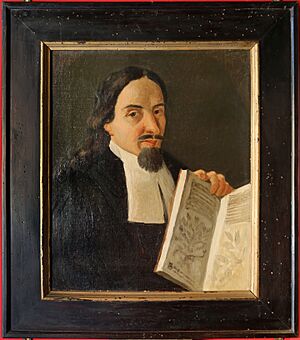Luca Ghini facts for kids
Quick facts for kids
Luca Ghini
|
|
|---|---|
 |
|
| Born | 1490 Casalfiumanese, Emilia-Romagna, Italy
|
| Died | 4 May 1556 (aged 65 or 66) Bologna, Italy
|
| Education | University of Bologna |
| Known for | Creating the first herbarium |
| Scientific career | |
| Fields | Physician and botanist |
| Institutions | University of Bologna |
| Notable students | Gherardo Cibo, Andrea Cesalpino, Pietro Andrea Mattioli |
| Author abbrev. (botany) | Ghini |
Luca Ghini (born in Casalfiumanese, 1490 – died in Bologna, 4 May 1556) was an important Italian physician and botanist. He is famous for creating the very first recorded herbarium (a collection of dried plants). He also started the first botanical garden in Europe.
Contents
Who Was Luca Ghini?
Luca Ghini was born in a town called Casalfiumanese. His father worked as a notary, which is like a legal secretary. Luca studied medicine at the University of Bologna.
By 1527, he was teaching students about plants used in medicine. He later became a full professor at the university.
Moving to Pisa and New Ideas
In 1544, Ghini moved to Pisa, but he still kept his home in Bologna. This year was very important for him and for botany.
He created the first herbarium, which he called hortus siccus (meaning "dry garden"). He would dry plants and press them flat between pieces of paper. Then, he would glue them onto cardboard. This was a new way to study and keep plant samples.
Sadly, none of Ghini's own herbaria have survived to today. However, a herbarium made by his student, Gherardo Cibo, around 1532, still exists.
Europe's First Botanical Garden
Also in 1544, Ghini helped start a special garden for live plants. This garden became known as the Orto botanico di Pisa. It was the first botanical garden in Europe. Here, scientists could study living plants from different places.
Ghini's Impact as a Teacher
Luca Ghini did not publish many big books about plants himself. But he was known as an amazing teacher. Many of his students went on to have very successful careers in botany.
For example, Cesalpino was one of his students. Cesalpino later took over Ghini's role as the director of the botanical garden. Another famous student was Pietro Andrea Mattioli. Ghini even helped Mattioli by traveling around the Mediterranean Sea and the Near East. He was looking for plants that matched old descriptions from a famous ancient writer named Dioscorides.
After Ghini passed away, some of his teaching methods were published in a work called Placiti.

